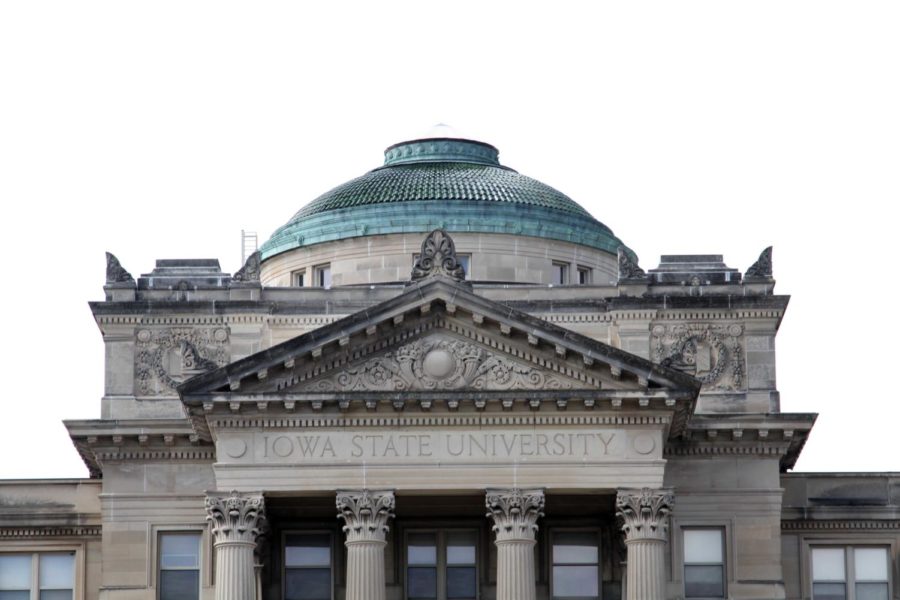Iowa State highest paid employees in 2017 all men, data shows
Beardshear Hall from Central Campus.
January 24, 2018
The 15 highest-paid employees at Iowa State in 2017 were men, seven of which were involved with Iowa State Athletics as coaches or directors.
Twelve of the 15 highest-paid professors were men, according to the state salary book.
Out of the 25 highest-paid lecturers, nine were women, the top 10 are men.
Lorraine Acker, director of the Margaret Sloss Women’s Center, said this is simply unacceptable and something needs to be done.
“Unless leadership says we need to address these inequalities it’s going to continue to just be a conversation, so how do we inspire students to take up this issue as critical?” Acker said.
There was a statistical difference in pay between male and female employees.
Lecturers
The highest paid female lecturer at Iowa State in 2017 was Julie Rursch, in the electrical and computer engineering department, who made $87,401.16. The highest paid male lecturer was Jeremy Sheaffer, in the computer science department, who was paid $124,361.69. That is a difference of $36,960.53, which translates to 29.72 percent.
Rursch has worked as a lecturer at Iowa State since 2012. Sheaffer has been a lecturer at Iowa State since 2015.
The 11 highest-paid lecturers were men.
There were two male lecturers who made more than any female lecturer with senior lecturer status.
Distinguished Professors
The highest paid male distinguished professor was Patrick S. Schnable, in the agronomy department, who made $371,369. The highest paid female distinguished professor, Catherine L. Kling, of the College of Agriculture and Life Sciences, who was the highest paid female employee at Iowa State in 2017, made $343,031.97.
There are 46 distinguished professors at Iowa State. Six of them are women, the rest are men, meaning nearly 87 percent of distinguished professors are men.
The average income of a female distinguished professor is $229,952.12 and $209,382.53 for men.
If you remove the two highest-paid female distinguished professors, who place in the top seven of wages for distinguished professors, the average falls to $192,232.58. The wage disparity in this case would be $17,192.95, or an 8 percent difference.
Deans/Administration
In November, Wendy Wintersteen became the first female president at Iowa State in its 160-year history. Before Wintersteen was promoted, she was the fourth highest-paid dean and the second highest-paid female dean.
There were 32 deans, associate deans, interim deans and assistant deans. Twenty of them were men, although five of eight college deans were women in 2017.
In 2017, more women were deans than men, but the two highest paid deans were men — one was an associate dean.
Employment Gap
These disparities are not only in wages, but also in hiring of lecturers, professors and administrators. There are 27 female lecturers and senior lecturers, to 50 males holding the same positions.
According to the Iowa State Fact Book, there were 1,966 faculty members at Iowa State in 2017, and 1,193, or 59.7 percent, were men. With 39.3 percent of Iowa State faculty being women in 2017, this is a slight decrease from the 39.4 percent in 2016 and 39.7 percent in 2015. The 39.3 percent in 2017 is identical to the percentage in 2014.
“Fifteen years ago, 32.3 percent of total faculty were female, to give you some perspective,” said Annette Hacker, director of News Service at Iowa State, who responded to inquiries from the Daily in an email on Wednesday afternoon.
Of the 979 tenured faculty members at Iowa State, 281 or 28.7 percent were women. Of the 1,362 total tenure eligible Iowa State faculty members in 2017, 447, or 32.8 percent were women.
National Statistics
A wage gap between men and women in the workforce is also observed at a federal level.
According to the Bureau of Labor Statistics, women made an average of $770.25 per week in 2017. This figure is $28 less than men made per week — in 2008.
In 2017, men made an average of 941.75 per week.
Since 2007, men’s wages have increased by 18.77 percent, lagging slightly behind the wage growth of women at 21.3 percent.
University Response
Hacker also directed the Daily to the 2016-2017 Diversity and Inclusion Report from the Office of the Senior Vice President and Provost for further information.
Hacker provided comment about efforts at Iowa State to increase diversity, particularly by involving women in leadership positions.
“Iowa State University has an ongoing commitment to diversity in experience and perspective. We work to attract robust applicant pools through the search process, which allows us to hire outstanding faculty and staff.
“It is certainly worth noting that Iowa State has a female president who also recently appointed two women to interim senior leadership roles–Pam Elliot Cain as interim senior vice president for university services and interim chief financial officer; and Kristen Constant as interim vice president and chief information officer. Iowa State’s interim Vice President for Human Resources Kristi Darr, is also female; as is Vice President for Research Sarah Nusser. We also have female deans in engineering, human sciences, liberal arts and sciences, and the library,” the email read.
Hacker also provided comment about questions regarding the disparity in the total of men and women employees at Iowa State in 2017.
“I see that 57.2 percent of current [professional and scientific] employees are female, and 56.1 percent of merit employees are female,” the email read.
The number of women merit employees decreased from 832 in 2013 to 748 in 2017, a 1.5 percent drop in the percentage relative to the total number. The number of women working as professional and scientific employees has increased by 287 in that time, accounting for 2.1 percent.

















